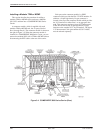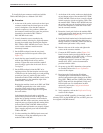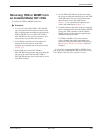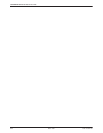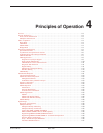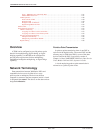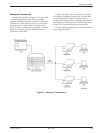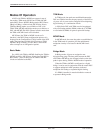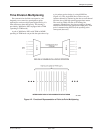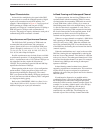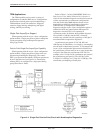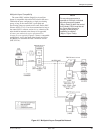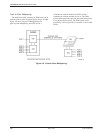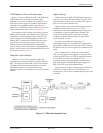
COMSPHERE 3600 Series Data Service Units
4-4 March 1999 3610-A2-GB41-60
Modes Of Operation
A DSU with TDM or MCMP can operate in one of
four modes: TDM mode (MUX Funct: TDM), MCMP
mode (MUX Funct: MCMP), Bridge mode (MUX Funct:
CBrdg or EBrdg), or Basic mode (MUX Funct: None).
TDM and Bridge modes are available to a DSU with
TDM; TDM, MCMP, and Bridge modes are available to a
DSU with MCMP. The DSU operates in Basic mode when
the TDM or MCMP circuit card is disabled.
MUX Funct (the TDM or MCMP circuit card’s
function) is the MUX Setup configuration option as it is
displayed in the Configuration (Confg) branch of the DCP
menu. The functions available in this section are TDM,
MCMP, CBrdg or EBrdg, or None (Basic). Each mode
offers a unique set of configuration options.
Basic Mode
For a DSU with TDM or MCMP, disabling the TDM or
MCMP capability (MUX Funct: None) places the DSU in
Basic mode – just as if there were no TDM or MCMP
circuit card attached to the DSU.
TDM Mode
In TDM mode, data paths are established between the
DSU and TDM to increase the port capacity of the DSU to
six ports. All six ports can be configured for multiplexing,
digital sharing, or a combination of both.
A 3600 Series DSU with TDM can also be equipped
with a dial backup module (DBM), either the V.32 DBM
or a Switched 56 DBM, for point-to-point dial backup.
MCMP Mode
In MCMP mode, the same data paths are established as
in the TDM mode of operation, plus the multichannel
multipoint circuitry is activated on the MCMP circuit
card.
Bridge Mode
In Bridge mode, all ports are assigned to one
digital-sharing group. The data paths between the DSU
and TDM or MCMP are also changed relative to the data
paths in place during TDM or MCMP mode of operation.
When the TDM or MCMP is configured as a digital
bridge, it can be used in conjunction with the control DSU
to support multipoint LADS operation, dedicated
multipoint dial backup, or expanded digital-sharing.
If a DBM is installed, it must be disabled or removed
to operate in Bridge mode.



